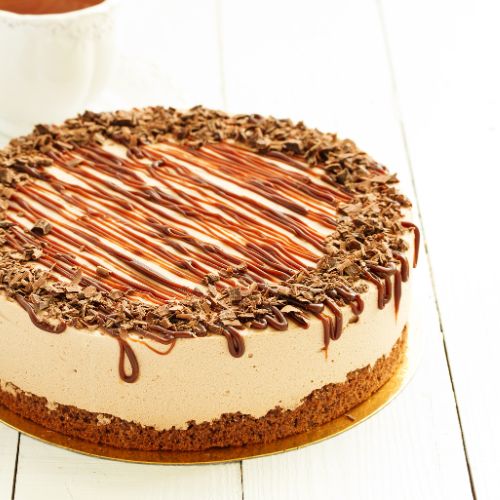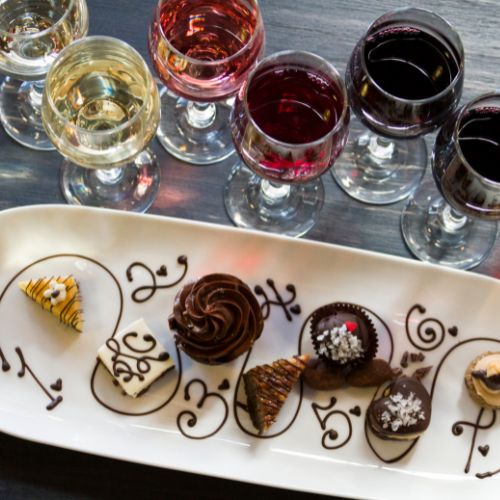
Caramel Desserts and Wine Pairing: A Gourmet Experience
Toasty, sweet, and luscious in texture, caramel is often a welcome addition to any cheese plate or dessert. It is an incredibly complex tasting ingredient, requiring the perfect temperature and cooking process to achieve the bold flavor and silky texture caramel is often known for. As it is a profoundly complex and endlessly customizable ingredient, […]
Read MoreToasty, sweet, and luscious in texture, caramel is often a welcome addition to any cheese plate or dessert. It is an incredibly complex tasting ingredient, requiring the perfect temperature and cooking process to achieve the bold flavor and silky texture caramel is often known for. As it is a profoundly complex and endlessly customizable ingredient, caramel is an excellent candidate for pairing with wine — The question is, what wine should you choose? From heady reds to crisp whites and even a couple of bubbly options, plenty of wines to serve alongside your next caramel confection are sure to match anyone’s palate.
How is Caramel Made?
One of the most popular flavors to add to a dessert, caramel is an excellent ingredient most commonly prepared as a sauce or hard candy. Although the process can be intense and vigorous, the steps to making caramel are simple.
Put simply, caramel is sugar that has been caramelized, the process by which sugar darkens, melts, and develops its well-celebrated caramel flavor. Either by dissolving in a small amount of water (A “wet” caramel) or by melting down dry sugar (a “dry” caramel), table sugar can be melted into a clear syrup that will darken and gain an amber color over time. Without adding any extra ingredients, a pure sugar caramel is ideal for desserts like French croquembouche or Korean tanghulu, highlighting the hard, shattery texture of a sugar caramel.
Otherwise, confectioners may add dairy to a caramel in the form of butter, milk, or cream. These dairy products add richness, buttery-ness, and thickness to the caramel, turning it from a shattering hard candy to a soft and silky sauce or malleable candy, depending on how long it is cooked down. Further, caramel makers may add salt, flavor extracts, and a variety of other additions to make their caramel uniquely flavored and specially designed for the dessert it will be served with.
What Wines to Pair with the Flavor Notes in Caramel
Like all other foods and desserts, the tastes and flavors present in caramel are referred to as “flavor notes.” Identifying and highlighting these flavor notes are great ways to understand what you are tasting, enabling you to decide what wine to pair with caramel.
Sweet – Tawny Port
The sweetness in caramel is thick, syrupy, and heavy, leaving a rich taste on your palate. This sweetness is different from the sweetness of fruit or candy, with its well-developed darkness and unctuousness. A Tawny Port can be a great pairing to support this robust and bold sweetness. A bit more subtle than its Vintage Port counterpart, Tawny Ports features a sharpness and fruitiness that will cut through the lingering richness of a caramel dessert but still highlight caramel’s deep, syrupy sweetness with notes of dried fruit and chocolate.
Toasty – Malbec
Caramel is more than just a sweet addition to desserts. The dark toastiness of a well-developed caramel can often evoke flavors of crème brûlée and toasted marshmallow, leaving a sharp and delightfully pungent note that pairs well with Malbec wines. Notable for its deep toastiness, Malbec wines tend to have notes of dried fruit and wood smoke, highlighting the heavy, darker flavors in your caramel and offering a sharpness and dryness that will counteract any lingering pungency.
Nutty – Riesling
An often overlooked note of dessert caramels, caramel usually has a fatty, earthy, and creamy quality similar to nuts on the palate. Riesling wine can be an excellent option to complement caramel’s creamy and fatty notes. A bright, sharp, and juicy white wine, Rieslings will cut through caramel’s fatty and thick texture with its acidic and fruity flavor, offering a refreshing contrast to the bold and developed caramel flavors.
Buttery – Nebbiolo
The dairy and creamy qualities of caramel can’t be overlooked, especially when caramel is added to a dairy dessert like ice cream, caramel pot de crème, or a caramel pecan pie. For red wine lovers, a Nebbiolo wine is an excellent selection for this quality, as it is rich, tannic, and has a fair bit of acidity. Nebbiolo wines will fare well against the buttery, concentrated flavor of caramel, offering a sharp and acidic flavor that balances the punchiness of caramel and finishes with a dry, clean palate that is ready to pair again.
Salty – Brut
Salted caramel is a regular favorite of many dessert lovers, offering small bursts of salt that shine against the bold sweetness of caramel. Brut wines can be a solid pairing for salted caramel in particular, encompassing a variety of dry, bubbly wines like Champagne, Cava, and other similar wines. Bruts work particularly well with caramel, as the wine’s dry bubbliness and light sweetness offer a refreshing, clean note that effortlessly balances any heavy caramel flavors, imparting a slight fruitiness that highlights the sweet and nutty notes natural to the caramel.
Many Ways to Enjoy Caramel
The flavor of a food isn’t all about how it tastes — it’s also about the texture and pairing of other flavors in the dish. Consider how you are serving your wine, whether alongside a meal or a grazing board and choose the caramel form to best serve alongside it! Caramel sauces are ideal for cheese and fruit boards, as they can be easily drizzled or dipped without getting your hands dirty. Caramel candies can be an easy addition to a grazing tray and are slightly sweeter than other caramels. Regardless of which form of caramel you choose, your next dessert dish will indeed be elevated by the specialty wine you’ve selected to serve alongside it.


